An apt description for the culture or fattening of mudcrab in mangrove areas is the process to produce food through aquaculture without sacrificing the environment. Net enclosures in mangroves or tidal zones offers a better alternative to pond culture.
Mudcrab culture in pens of Anduhaw, Inc entails the enclosure of mangrove stands with bamboo-supported netting. The shape of the enclosures are rectangular net pens, complete with walkways, particularly around new reforested mangrove areas and a guard house.
There is protocol in taking care of the stock, from stocking to feeding to selective harvest.
Sorting males from females, and stocking separately. Stocking similar-sized crabs of the same species in the same pen to reduce fighting and cannibalism.
Monitoring water quality, watching for signs of diseases and abnormalities, and feeding the stocks. Feeds they used include trashfish and mussel meat which are given at 10% of crab biomass per day. They gave 40% of the feed early in the morning and the rest in late afternoon. Culture time can take 15-30 days
Weekly weight and carapace length measurements to adjust feed ration.
Selectively, the group harvested marketable-sized crabs and sold to the market.
Important Notes:
There were 15-groups who are scheduled daily to protect the stocks. Each group consisting of four members i.e., two member to oversee at daytime while the other two-member for the night.
It was amazing to note that there are testimonies among the Anduhaw group that the mud crab fattening project of NACSEA Relief has brought closer bonding of husbands and wife with their children. Husbands who were not members, became interested to join especially after having experienced to accompany their wives to do their duty at night for safekeeping the project.
Increased membership was also noticed and volunteerism spirit are very warm in every way. Before, they have to do house-to-house to invite people to become members but this not anymore today.
There were also testimonies that the project is not only very educational but also awakening as natural habitat is readily available and can be used to make a living. The group would like to apply what they have learned through this project as another means of livelihood for their respective family.
This project has also opened another opportunity for group as per Chairman Baid that the Dept of Agricuture will apparently support them for milk fish farming near our crab fattening site.
The Project site has become a meeting place whenever they have visitors. First guest they had was from DENR who tasked them to do planting of mangroves. Planting activities are being paid and Anduhaw members have benefited from it.































Previous post
Senden Home visits NACSEARelief
Next post
School necessities turned into joy and pride. Thanks to Canadian generosity